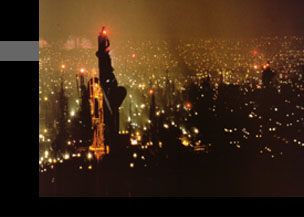The medium of film offers a new way of experiencing our world – free of the physical and material constraints of reality. With this medium the filmmaker has infinite possibilities in their manipulation of the architectural environment, which they provide with histories and patterns of use, endowing the film with layers of meaning. As such they are able to move beyond conventional perceptions of our reality, creating psychologically charged spaces, which act to expose the intricacies of the underlying narrative.
“ The set in order to be a good set, must act. Whether realistic, expressionistic, modern, or historical, it must play a role … The set must present the character before he appears, must indicate his social position, his tastes, his habits, his lifestyle, his personality” [1]
This essay will demonstrate the various forms of dialogue between cinematic plot and architecture. The selection of films works to illuminate different major roles of set design and architecture in film – such as an expression of our unconscious mind (Golem and Caligari), a dystopic vision of our immanent future (Metropolis and Blade Runner), and a commentary on the state of our modern world (Playtime and Truman Show).
|





